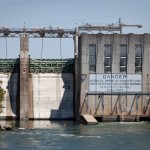How Wind’s Success in Texas Could Pave the Way For More Solar

Photo by Melanie Conner/Getty Images
Wind energy has taken off in Texas, and it could help solar do the same.
The Texas wind boom really got started over a decade ago, with the passage of a state senate bill that required renewables to be developed, followed by an expanded version of renewable energy targets from the senate in 2005.
“Since then, we’ve been off to the races,” says Warren Lasher, the Texas grid’s system planner. He appeared on a panel on solar and wind development in Texas at the SXSW Eco conference last week. Now there are about 6,500 wind turbines in Texas. You’ll mostly find them in the panhandle, and some on the coast. Texas is the biggest wind energy state in the country, and one of the largest wind energy producers in the world, with more wind capacity than France, Italy or Great Britain, as of the beginning of this year. (A federal tax credit – now being lambasted by some state officials and power companies – also helped.)
Most of that wind is in the panhandle, the incubator for Texas’ experiment with renewables. It can get quite gusty there. “The trees kind of tilt to the side up there,” Lasher joked. “And now transmission lines do, too.”* They’re designed to change direction with the wind (as it inevitably does), which reduces stress from torque on the turbine, resulting in less maintenance.
But while there’s plenty of wind – and now plenty of turbines – in the panhandle, there aren’t that many people. 85 percent of the state’s population now lives in cities, and that number is growing.
“The issue here is, the renewable energy centers are typically very different from the urban centers,” Lasher said. “So that results in a cost: building transmission lines.”
To solve that problem, enter the Competitive Renewable Energy Zones (CREZ) transmission line projects. They run for over 2,300 miles and are currently pegged at a cost of almost $7 billion. “But that allows us to connect reliably 18,500 megawatts of wind,” Lasher said. That’s enough to power 3.7 million homes on a hot August day in Texas, and it’s enough capacity for nearly double the amount of turbines currently in the entire state. Once the lines are up and running, they’ll be able to carry enough wind energy to supply a significant amount of the state’s energy needs on an average day.
And Lasher points out that those transmission lines could carry more than just wind. There’s a lot of flat, sunny land in the panhandle – perfect for solar farms.
“We’ve learned a lot from wind integration here in Texas,” Lasher says. “And one of the great things about solar is that we’re not first. We’re going to be able to learn from others”
One advantage to solar is that long-term forecasting will be easier than it is for wind, Lasher says. “But when a cloud comes over the power can drop very quickly,” he adds, so it will be important to have a responsive,
Another advantage Lasher sees for solar in Texas in the coming years is speed. Solar farms can “be built very quickly and easily,” he says, taking only nine to twelve months to build a large facility. And they’re flexible, too. “They can be built in small chunks and spread around the system,” Lasher says, “which does a lot for system reliability.”
Rolando Pablos, a commissioner of the Public Utility Commission of Texas, lent some vocal support to renewables at the panel. “The most important project is to make sure that we keep [renewables] at the table with the CREZ line system,” Pablos said, noting that the lines had been designed with renewable energy in mind. He added that he wants the commission to “get creative” with renewables in order to make sure they “stay in the conversation.”
To that end, Pablos noted, the commission recently passed rules that will make it easier to bring in energy storage technology.
“For me, it’s important that we help the renewable industry with its research and development efforts,” Pablos said. “As prices drop, [renewable energy] becomes more competitive.”

